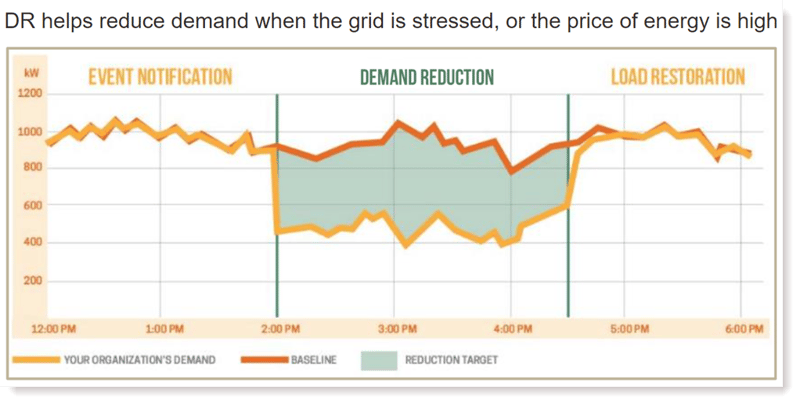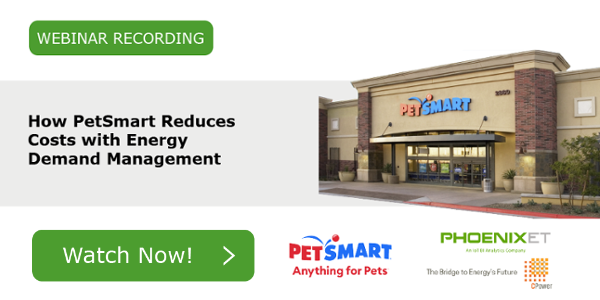Share this
[Webinar Recording] How PetSmart Reduces Costs with Energy Demand Management
by Phoenix Energy Technologies on Mar 1, 2022
![[Webinar Recording] How PetSmart Reduces Costs with Energy Demand Management](https://www.phoenixet.com/hs-fs/hubfs/1-Mar-01-2022-08-21-11-32-PM.png?width=800&name=1-Mar-01-2022-08-21-11-32-PM.png)
[Webinar Recording] We've been running some terrific webinars this year, with a riveting feature in early February featuring PetSmart and CPower energy experts outlining how multi-site enterprises can reduce costs through demand response programs. Read the session's breakdown here.

Our webinar panel includes:
- Ryan Adelman, VP of Business & Corporate Dev, Phoenix Energy Technologies
- Rachael Ruelas, Manager, Energy & Sustainability, PetSmart
- Jay Snyder, Manager, Field Integration & Technology Alliances, CPower
- Nate Soles, VP National Accounts, CPower
The primary goal of the discussion was to discuss how multi-site enterprises can reduce costs through energy demand management and demand response (DR) programs, with PetSmart offering a real-world example.
The Energy Marketplace is Changing
Our panel began discussion on how the energy landscape for multi-site retailers is evolving. They discuss how new methods of generation and distribution have influenced things. There is also a brief analysis on how disruptive events, such as COVID and extreme weather, may have long-term ripple effects that impact rates and strategic decision-making.
![[Webinar Recording] How PetSmart Reduces Costs with Energy Demand Management](https://www.phoenixet.com/hs-fs/hubfs/demand%20response_3.png?width=800&name=demand%20response_3.png)
Effective Demand Response Programs
The panel covers how effective demand response programs allow companies to prepare for changes across their energy landscape. They talk about the benefits of high-quality demand response partnerships. They indicate that these partnerships can give companies the expertise to isolate the exact energy management approach they should use for their multi-site needs. The panel add that such partnerships offer methods for using existing controls to automate and monitor demand response performance for each unit, zone, or building.

Retailers Want Solutions!
Scalable Demand Response That Fits Specific Needs
Regardless of the portfolio size and geographic distribution, enterprise retailers are looking for demand response programs that align with business requirements, prioritizes occupant comfort, and maintain inventory integrity. The panel says those expectations can be met through partnerships that combine multi-building, multi-site management to recognize local site needs.
Making Demand Response Programs Work
While retailers understand the broad benefits of implementing a demand response program, they may lack the resources to work with the complexities of demand response. The panel lists three factors that reduce the complexity of DR:
- A unified approach to controls
- Stability
- Sustainable curtailment strategies
The panel discusses how each of these factors assists retailers with navigating varying event characteristics, different load requirements, and complex technical issues.
Are Demand Response Programs Daunting to Set Up?
Enterprise retailers cover multiple sites across large geographic regions. As a result, building an internal energy demand management program may seem like an impossible task. However, scalable demand response gives flexibility for aligning performance with multiple legacy building automation systems. The capability to reduce complexity while matching performance needs allows retailers to reduce costs and improve revenues.
The panel highlights three basic factors that drive DR programs.
- Repeatable revenue
- Grid resiliency
- Sufficient resources
The panel also discusses how a good DR partnership can determine the best methods for aligning DR drivers from their customer's (the retailer's) perspective. Building repeatable revenue through a DR program allows retailers to invest in their corporate energy strategies. Gaining grid resiliency and assuring the availability of sufficient energy resources prevents grid emergencies from disrupting occupant comfort and endangering the integrity of inventory.
The Power of a National Presence Supports Unique Customer Requirements
No matter the size or geographic coverage, companies have distinctive requirements for energy management. PetSmart's energy management strategy not only covers the comfort of 52,000 employees but also encompasses the company motto of "Anything for Pets." Achieving safety and moderation within energy management eliminates any impact on critical pet-focused business operations.
Working closely with PetSmart, CPower and Phoenix Energy Technologies saw an opportunity to build a customer-focused demand response program. With a balanced approach that leverages the knowledge and skill of national teams with local team perspectives, the panel outlines the key ingredients to overcoming technical and logistical challenges through demand response.
![[Webinar Recording] How PetSmart Reduces Costs with Energy Demand Management](https://www.phoenixet.com/hs-fs/hubfs/demand%20response_2.png?width=800&name=demand%20response_2.png)
As a result, PetSmart achieved a modest DR strategy with considerable benefits. The panel discussion highlights how companies can reduce consumption, demand, and strain on the grid while gaining incentive revenue and enhancing environmental stewardship efforts.
Energy Demand Management Q&A
The webinar includes panel responses to questions. However, because of time restrictions, some questions were answered following the event and are as follows:
WEBINAR Q: How do you know the stores are not too hot during events?
Rachael Ruelas, PetSmart: Our building management systems and partnership with Phoenix Energy Technologies allow us to monitor conditions in the store and if they drift outside our preset parameters we allow the HVAC to come on.
WEBINAR Q: Do you tell the stores in advance?
Rachael Ruelas: No, because our curtailment isn’t designed to be noticeable and we didn’t want the power of suggestion to make people take notice. We don’t curtail lighting and we don’t curtail HVAC in service areas. Just to make sure we were honest with ourselves, I asked Phoenix Energy Technologies to compare call numbers with DR events and they found no increased correlation.
WEBINAR Q: Do you tell customers you participate in Demand Response?
Rachael Ruelas: We don’t, but I think you could if it fits your sustainability strategy. I’ve seen some retailers here in Arizona put window clings on the door explaining that lighting may be reduced to help the utility during usage peaks. It’s a business decision, really.
WEBINAR Q: Have you ever had a time when you performed badly?
Rachael Ruelas: Sometimes, but not often. If it is brutally hot sometimes our curtailment efforts aren’t enough. Sometimes we are working on underlying mechanical issues at the store. Fortunately CPower helped us curate the programs we participate in so we don’t incur any non-participation fees.
The comfort and safety of our People and Pets always comes first and if that means we have to sacrifice curtailment that choice is always clear. When it does happen, we can look back at performance compared to monitoring data and Phoenix Energy Technologies can help identify anomalies.
WEBINAR Q: How often do demand response events occur?
Nate Soles & Jay Snyder, CPower: It varies by program- some are as little as one event for an hour per year, while others allow a customer to determine their own threshold that could enable frequent events. It is important to design curtailment strategies to match the intended frequency. We usually guide new participants towards programs with the best value per expected event hours.
WEBINAR Q: How do we know how much load we can curtail without sacrificing occupant comfort?
Phoenix Energy Technologies: Phoenix uses inputs from our customers like corporate set points standards, occupancy patterns, and store operating hours along with in-house estimation tools to determine how much load can be curtailed and for how long before occupants become aware. As well, most Phoenix customers outsource their energy and comfort monitoring to our EMS call center, so we can quickly respond to any comfort issues associated by a DR event.
WEBINAR Q: How do we measure how we’ve performed?
Phoenix Energy Technologies: Phoenix performs Measurement and Verification (M&V) for all our customers who use our full suite of professional services or pay for Demand Manager. This formal M&V process is documented for the customer as part of the contracting process for full transparency. Because Phoenix continuously monitors equipment set points, run time, we regularly compare these run-times against the building’s baseline to accurately report how much calculated load has been curtailed. Further, the Curtailment Service Provider (CSP) also provides reports from utility logs to verify curtailment activity.
WEBINAR Q: Do we receive payments even if we are not called on to curtail?
Phoenix Energy Technologies: Yes, many programs are designed around resource availability, and provide earnings even if no grid-emergency curtailment events occur. Most programs have an annual test event to validate performance.
WEBINAR Q: Can we opt out of an event?
Phoenix Energy Technologies: Yes, Demand Manager makes it easy to opt out of any event if permissions are granted by the customer.
Check out the full webinar presentation and discussion to learn more! Start learning how you can best plan your energy demand management needs.
Share this
- Facilities Management (91)
- Energy Management (69)
- Company News (49)
- Smart Buildings (37)
- Retail (36)
- Building Management (24)
- Building Automation Systems (21)
- Sustainability (20)
- Energy Demand Management (19)
- EEI (15)
- Adaptive Energy Management (14)
- Grocery (14)
- demand response (14)
- Artificial Intelligence (12)
- Data Integration and Visibility (10)
- HVAC IQ (9)
- COVID-19 (8)
- Customer Spotlight (8)
- Carbon Management (7)
- Setpoints and Temperatures (7)
- Equipment Maintenance (6)
- Operational Efficiency (6)
- Refrigeration Optimization (6)
- Ask Ron (5)
- Asset Manager (5)
- Finance and Procurement (5)
- IoT and Digital Transformation (5)
- Awards (4)
- Comfort (4)
- Energy & Store Development (4)
- Safety and Compliance (4)
- Demand Charge Management (3)
- Energy Management System (3)
- Lifecycle Asset Management (3)
- Premium Services (3)
- Refrigeration IQ (3)
- Automated Demand Response (2)
- ConnexFM (2)
- Customer Service (2)
- HVAC Vendor Management (2)
- Load Shedding (2)
- Technician View (2)
- AIM Act (1)
- ALD (1)
- Analytics (1)
- Data (1)
- Data Integration and Visualization (1)
- EMS (1)
- Knowledge Center (1)
- OSHA (1)
- asset management (1)
- December 2025 (1)
- November 2025 (1)
- October 2025 (2)
- September 2025 (1)
- August 2025 (3)
- July 2025 (1)
- June 2025 (1)
- May 2025 (2)
- March 2025 (2)
- February 2025 (1)
- January 2025 (2)
- December 2024 (2)
- October 2024 (1)
- September 2024 (1)
- August 2024 (2)
- June 2024 (2)
- April 2024 (2)
- March 2024 (2)
- January 2024 (1)
- December 2023 (1)
- October 2023 (2)
- September 2023 (2)
- August 2023 (2)
- July 2023 (1)
- May 2023 (2)
- April 2023 (2)
- March 2023 (3)
- February 2023 (1)
- January 2023 (1)
- December 2022 (1)
- November 2022 (2)
- October 2022 (2)
- September 2022 (1)
- May 2022 (2)
- April 2022 (1)
- March 2022 (3)
- February 2022 (2)
- January 2022 (4)
- December 2021 (2)
- November 2021 (3)
- October 2021 (1)
- September 2021 (3)
- August 2021 (4)
- July 2021 (1)
- June 2021 (2)
- May 2021 (1)
- January 2021 (2)
- December 2020 (2)
- November 2020 (2)
- October 2020 (3)
- September 2020 (4)
- August 2020 (3)
- July 2020 (2)
- June 2020 (3)
- May 2020 (3)
- April 2020 (5)
- March 2020 (5)
- February 2020 (4)
- January 2020 (4)
- December 2019 (4)
- November 2019 (3)
- October 2019 (4)
- September 2019 (5)
- August 2019 (4)
- July 2019 (4)
- May 2019 (2)
- April 2019 (3)
- February 2019 (1)
- December 2018 (1)
- November 2018 (1)
- October 2018 (3)
- September 2018 (3)
- August 2018 (3)
- July 2018 (3)
- June 2018 (3)
- May 2018 (1)
- June 2015 (1)
- March 2013 (1)
- January 2013 (1)
- December 2011 (1)
- October 2011 (1)
- September 2011 (1)



